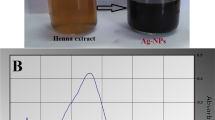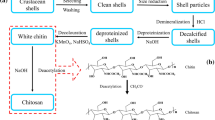Abstract
The antibacterial effect of chitosan with different molecular weights was investigated to define their potent biological activity. Both chitosan hydrolysates designated to CTSN-P30 and CTSN-B8 derived from the hydrolysis of high molecular weight chitosan showed significant synergistic antibacterial effects toward Staphylococcus aureus in the presence of 1,3-butylene glycol. The concentration-dependent antimicrobial effect is very important in determining the minimum inhibitory concentration (MIC) of both CTSN-P30 and CTSN-B8. Each MIC50 of CTSN-P30 and CTSN-B8 was determined to be about 25 and 50 µg/mL, respectively. Among chitosan hydrolysates, CTSN-P30 can effectively protect the membrane from the penetrating of fine dust which may contain unspecified microorganisms. Also, CTSN-P30, which showed very significant antimicrobial activity, was confirmed to be a hydrolysate containing (GlcNAc)3, and other hydrolysates consisting of (GlcN)5 to (GlcN)15 using matrix-assisted laser desorption/ionization-time of flight (MALDI-TOF) mass spectrometry analysis. These results demonstrated the feasibility of CTSN-P30 and 1,3-butylene glycol to use as a potent antibacterial and find a dustproof agent for the preparation of various industrial products.

Similar content being viewed by others
References
C. A. Brown, B. Wang, and J. H. Oh, J. Food Prot., 71, 319 (2008).
J. C. Fernandes, F. K. Tavaria, J. C. Soares, O. S. Ramos, M. J. Monteiro, M. E. Pintado, and F. X. Malcata, Food Microbiol., 25, 922 (2008).
M. Kaya, M. Asan-Ozusaglam, and S. Erdogan, J. Biosci. Bioeng., 121, 678 (2016).
T. Kinnunen and M. Koskela, Acta. Derm. Venereol., 71, 148 (1991).
M. Abbas, T. Hussain, M. Arshad, A. R. Ansari, A. Irshad, J. Nisar, F. Hussain, N. Masood, A. Nazir, and M. Iqbal, Int. J. Biol. Macromol., 140, 871 (2019).
N. Alizadeh and S. Malakzadeh, Int. J. Biol. Macromol., 147, 778 (2020).
J. Radwan-Praglowska, M. Piatkowski, V. Deineka, L. Janus, V. Korniienko, E. Husak, V. Holubnycha, I. Liubchak, V. Zhurba, A. Sierakowska, M. Pogorielov, and D. Bogdal, Molecules, 24, 2629 (2019).
E. Szymanska and K. Winnicka, Mar. Drugs, 13, 1819 (2015).
J. Zhang, W. Xia, P. Liu, Q. Cheng, T. Tahirou, W. Gu, and B. Li, Mar. Drugs, 8, 1962 (2010).
W. Dong, B. Han, K. Shao, Z. Yang, Y. Peng, Y. Yang, and W. Liu, J. Mater. Sci. Mater. Med., 23, 2945 (2012).
J. Kumirska, M. X. Weinhold, J. C. Sauvageau, J. Thöming, Z. Kaczyński, and P. Stepnowski, J. Pharm. Biomed. Anal., 50, 587 (2009).
D. Das and N. Das, J. Hazard. Mater., 278, 597 (2014).
T. Akther, M. Ahmed, M. Shohel, F. K. Ferdousi, and A. Salam, Environ. Sci. Pollut. Res. Int., 26, 5475 (2019).
B. Dogra, S. Amna, Y. I. Park, and J. K. Park, Macromol. Res., 25, 172 (2017).
S. Y. Chae, M. K. Jang, and J. W. Nah, J. Control Release, 102, 383 (2005).
Y. Chen, X. S. Luo, Z. Zhao, Q. Chen, D. Wu, X. Sun, L. Wu, and L. Jin, Ecotoxicol. Environ. Saf., 165, 505 (2018).
M. Soleimani, N. Amini, B. Sadeghian, D. S. Wang, and L. P. Fang, J. Environ. Sci., 72, 166 (2018).
C. A. Spence, R. D. Boyd, C. D. Wray, and D. M. Whitehead, J. Anim. Sci., 60, 1280 (1985).
M. Lever, Anal. Biochem., 81, 21 (1977).
M. Lever, T. A. Walmsley, R. S. Visser, and S. J. Ryde, Anal. Biochem., 139, 205 (1984).
S. Mushtaq, J. A. Khan, F. Rabbani, U. Latif, M. Arfan, and M. A. Yameen, J. Med. Microbiol., 66, 318 (2017).
C. Vasile, M. Sivertsvik, A. C. Mitelut, M. A. Brebu, E. Stoleru, J. T. Rosnes, E. E. Tanase, W. Khan, D. Pamfil, C. P. Cornea, A. Irimia, and M. E. Popa, Materials, 10, 45 (2017).
A. Y. Yoo, M. Alnaeeli, and J. K. Park, Process Biochem., 51, 463 (2016).
Y. H. Lee, S. Y. Park, J. E. Park, B. O. Jung, J. E. Park, J. K. Park, and Y. J. Hwang, Int. J. Mol. Sci., 20, 3085 (2019).
J. Jirawutthiwongchai, I. Y. Klaharn, N. Hobang, K. Mai-Ngam, J. Klaewsongkram, A. Sereemaspun, and S. Chirachanchai, Carbohydr. Polym., 141, 41 (2016).
H. Sakaguchi, M. Watanabe, C. Ueoka, E. Sugiyama, T. Taketomi, S. Yamada, and K. Sugahara, J. Biochem., 129, 107 (2001).
E. Vinogradov and K. Bock, Carbohydr. Res., 309, 57 (1998).
A. Teimouri, S. J. Azami, H. Keshavarz, F. Esmaeili, R. Alimi, S. A. Mavi, and S. Shojaee, Int. J. Nanomed., 13, 1341 (2018).
R. Singh, T. Weikert, S. Basa, and B. M. Moerschbacher, Sci. Rep., 9, 1132 (2019).
K. Seki, Y. Nishiyama, and M. Mitsutomi, J. Biosci. Bioeng., 127, 425 (2019).
S. A. Kashif and J. K. Park, Macromol. Res., 27, 551 (2019).
Author information
Authors and Affiliations
Contributions
JKP and YJH conceptualized the idea, designed and coordinated the study. SYP performed the preparation of chitosan hydrolysates with different molecular weights, and YHL performed antibacterial and dust-proofing experiments. JKP supervised and edited the manuscript, YHL generated fund, YJH provided technical comments for the study. All authors read and approved the final version of the manuscript before submission.
Corresponding authors
Additional information
Publisher’s Note
Springer Nature remains neutral with regard to jurisdictional claims in published maps and institutional affiliations.
Acknowledgment: This work was carried out based on financial support (202105740001) from Foodyworm, Co., Ltd., which was supported by ⌜Green Bio Venture Start-up Business Support Project⌝ Ministry of Agriculture, Food and Rural Affairs, Republic of Korea (Organization in charge: Foundation of Agri, Tech, Commercialization & Transfer). Also, this work was supported by the Gachon University research fund of 202106680001.
Rights and permissions
About this article
Cite this article
Lee, Y.H., Park, S.Y., Hwang, Y.J. et al. Molecular Weight Determination of Chitosan with Antibacterial Activity Using Matrix-Assisted Laser Desorption/Ionization-Time of Flight Mass Spectrometry Analysis. Macromol. Res. 30, 90–98 (2022). https://doi.org/10.1007/s13233-022-0013-0
Received:
Revised:
Accepted:
Published:
Issue Date:
DOI: https://doi.org/10.1007/s13233-022-0013-0




